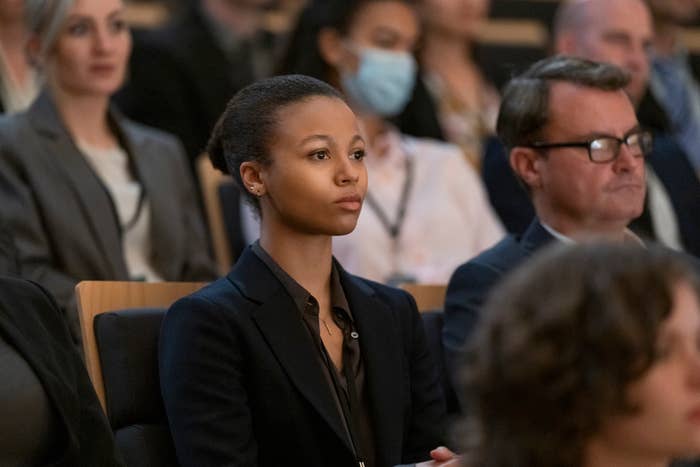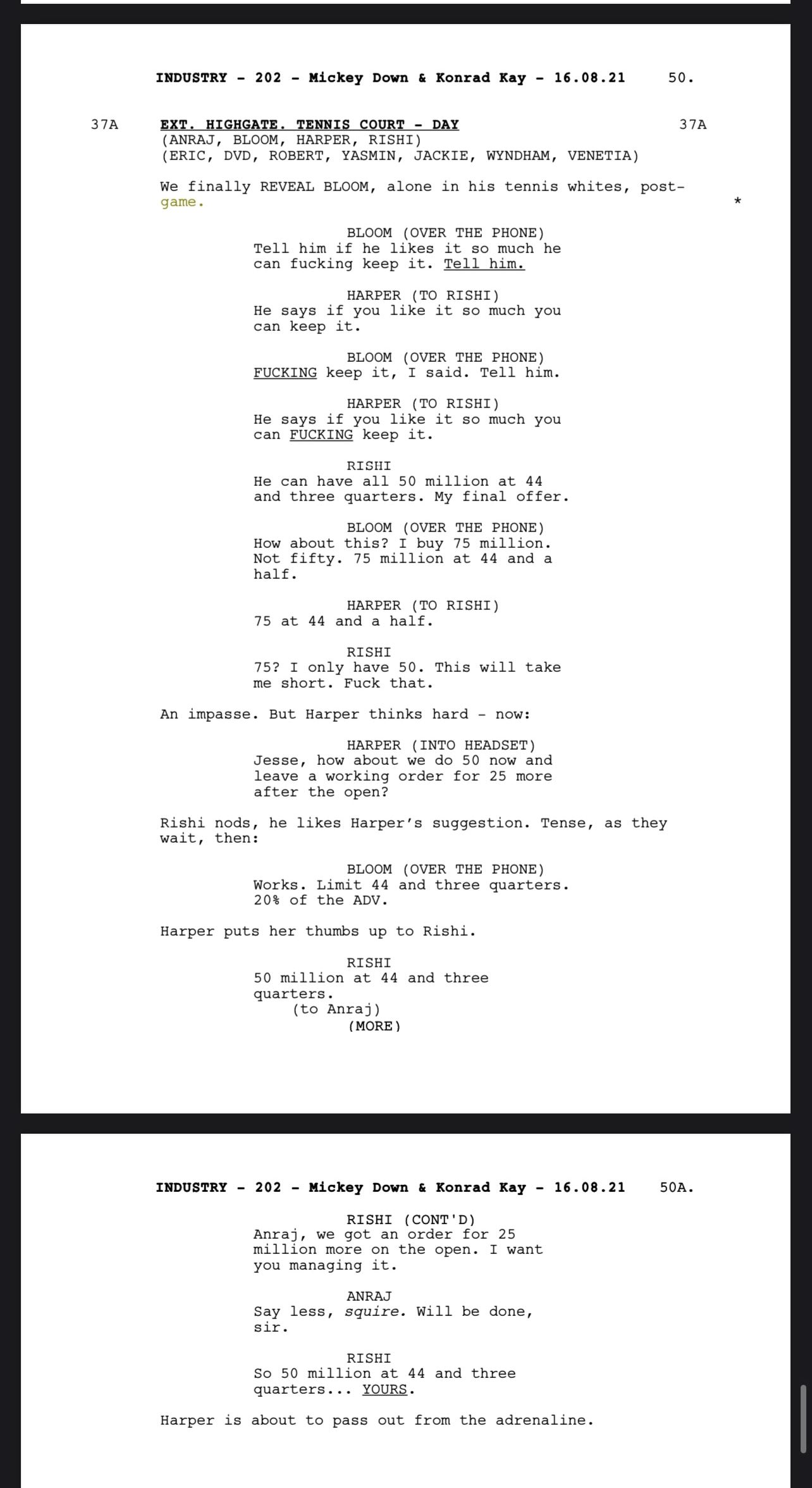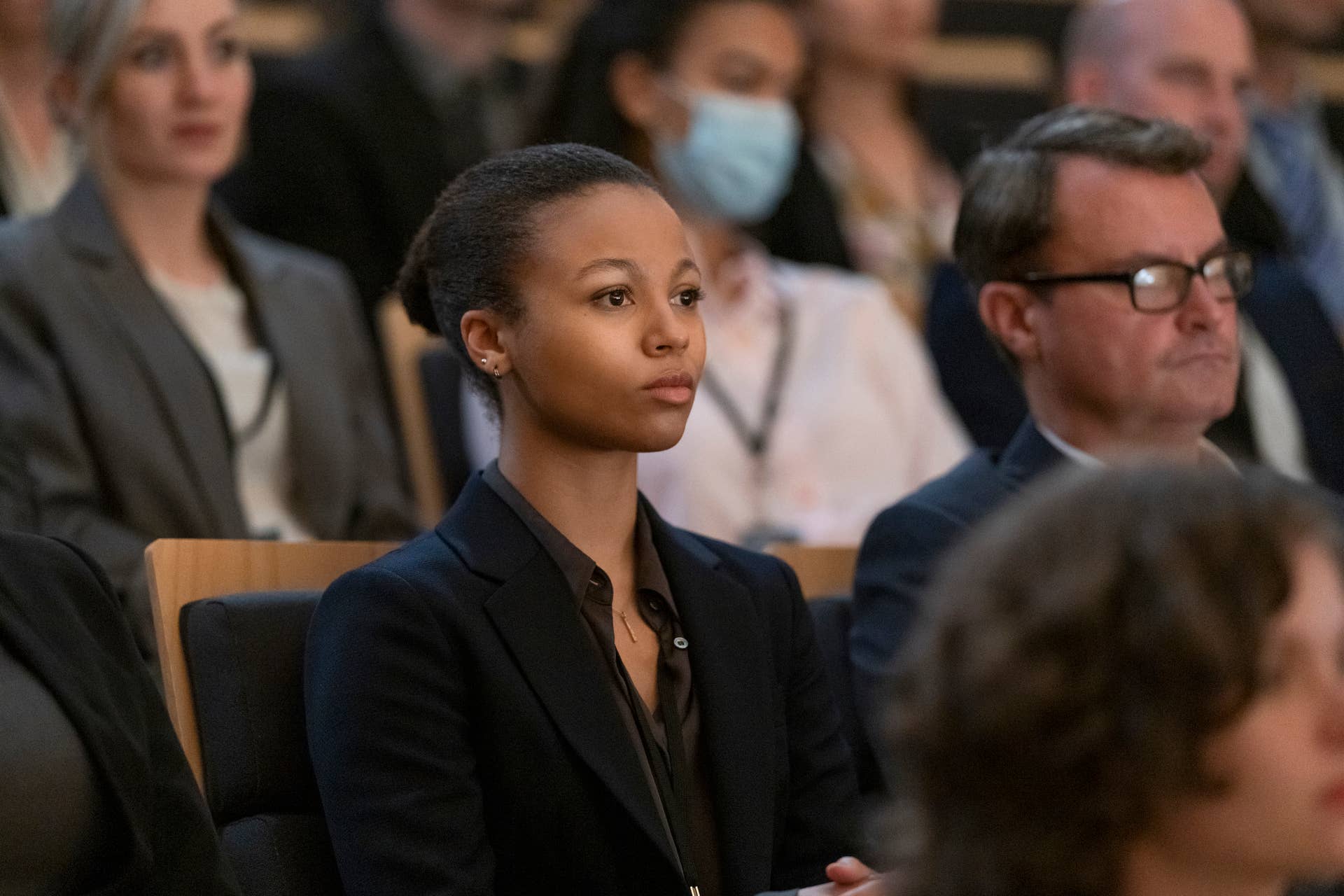
Industry just aired its best episode yet. The HBO series, now in its sophomore season, quickly established itself as a compelling workplace drama; the first season explored the lives of new recruits into Pierpiont & Company, an investment bank in London’s version of Wall Street. As college graduates jockeyed for long-term positions and placements in the company, Industry turned into a compelling survival of the fittest and an insightful look into the lives of young 20-somethings and how they all manage this high-pressure situation where fortunes can be made, or lost, in seconds.
As Season 2 begins, Harper Stern (Myha’la Herrold) is struggling. After a massive panic attack during the first season’s finale (and a global pandemic that kept her away from the Pierpoint offices), she’s unsure where she stands with her manager Eric (Ken Leung), and with her fellow Pierpoint colleagues. To make matters worse, Pierpoint’s New York office is considering shutting down the London location unless they can produce. With her back against the wall, Harper decides to go big buck hunting, aiming to bag Jesse Bloom (Jay Duplass), an American hedge manager who made so much money off of the pandemic that he’s now known as “Mr. Covid.” And, in the recently aired second episode, Harper bags her buck.
Harper’s sale to Bloom comes in the form of a gripping sequence that is among one of the best directed, best written, and best-edited sequences of the year. Even if you don’t understand every bit of banking jargon, the scene is electric. “We need [it] to feel as exhilarating as a car chase and action sequence,” Industry co-creator Konrad Kay tells Complex. It works; the sequence feels as kinetic as a shootout you’d see in an action movie like Heat but with stock prices.
Complex spoke with Industry’s co-creators, Mickey Down and Konrad Kay, for an expansive conversation around how the sequence came together, how they structured it within the larger arc of the show’s second season, casting Jay Duplass as Jesse Bloom, and much more. Also, the two provided a few of the actual script pages from episode two to illustrate how it came alive from page to screen. Needless to say, spoilers for Industry’s Season 2 are below. This interview has been condensed for length and clarity.



The last 10 minutes or so of Episode 2 are tense, gripping, and electric to watch unfold. How much of that direction was included in the script? Or was it something that you guys and [director] Birgitte [Stærmose] figured out on the day of?
KK: It’s a great question. It was a quite laborious scene to write. When me and Mickey first wrote Episode 1 of Season 1, there’s a trade at the end of that—where Harper trades with Rishi for the first time—and in the script, very explicitly, we wrote, “What unfolds now feels like a car chase.” What we never really quite achieved in Season 1—even though that scene works—was [that] we always wanted to write a banking sequence that felt like a scene from an action movie, as ridiculous as that sounds. So me and Mick were like, “Basically, this is gonna be the set piece of Episode 2. It’s gonna be the culmination of this storyline with Jesse. We need [it] to feel as exhilarating as a car chase and action sequence.”
So immediately, what we thought was, [that] any great action sequence—or any sequence like this—is just a question of obstacles and how many you can throw a character in the shortest amount of time possible. So when we were writing it, me and Mick were constantly thinking, “Okay, this has to have many stages to it. All of them have to be in the script. Everything that can go wrong has to go wrong. She has to have at least three moments in it where she’s the one either piecing something together or using her brain to connect this and this.” We also wanted to—without pushing it into like ridiculous length—become just this constant negotiation where when one party—Jesse—was satisfied, the trader wouldn’t be satisfied. When the trader wasn’t satisfied, her boss wasn’t satisfied. So all of that was in the script.
The other part of it was me and Mick are very obsessed with the idea of process. It was really important to us that—one of my favorite bits in the whole series of Season 2 is when Jesse says to Harper, “If you click me out of the line again, you’ll never hear from me again.” That is something that only people who’d fully researched a sequence like that would know that a client would say at that point. This is a long-winded way of saying a lot of the work was actually done on the page. Mick, remind me, how did we engage with Birgitte on it?
MD: Jumping on what you said about the practicalities of filming something like that, there are technical things that Harper does in that scene which you can only really understand if you’ve worked on a trading floor or spoken to someone that works in [a] trading floor. For example, she uses the hoot, which is this intercom system between desks. We had to explain to the director what it was because, on the page, it actually wasn’t very clear what the actual thing is. Me and Konrad sometimes just write “the hoot,” or we just write something with the knowledge of some people who have worked on a trading floor. All the people who work on the show, from the other writers to directors, to everyone who works on the production, come out this show with a sort of base knowledge and understanding that probably make them be able to get a job [in banking]. They’ve just taken in so much information.
Birgitte lived and breathed this stuff. She just asked question over question. She was like, “What would Harper say then? What button would that do?” We had such good production designers this season making sure all the systems in place on the trading floor—the Hoot, the Intercom system, the deal board—all were exactly as they would be. All the actors were trained in how to use this stuff. It’s all done live. There was very little audio tech manipulation or anything. It was just a constant conversation and a question back and forth between the directors and us about how it’s going. Jami O’Brien was on set all the time. Me and Konrad were on set a lot, especially for big trading floor sequences. By the end, to be honest, the directors were so ensconced in the world that they were doing it without our input.
KK: Totally. The choreography of something like this, you can’t write a functional script where you map all that stuff out. It’s impossible. The directors were brilliant at getting on top of it, but it is just a constant dialogue. The actors have so many questions in a sequence like that, practical ones [like] the level of tension in their voice, how to stand, how to react to certain things. So there was a constant like Q and A between takes. It was a super, super fun thing to do because as we wrote it, we set out for it to be ambitious, and we knew it was gonna take a lot of time to get right; it was fun to watch come together.



MD: The difference between Season 1 and Season 2 is that in Season 1, you never see who’s on the other end of the phone. Which was actually a creative choice that we made, which practically wasn’t very, [laugh] satisfying, shall we say. We were like, “We’re in these Grad’s heads. We only really care about them. The disembodied voice, the phone from a client, we don’t really give a fuck about, ‘Is it important?’” And we were like, “But then that makes for a pretty boring scene where it’s basically on Myha’la’s face constantly.” I think, actually, Myha’la joked that basically, a lot of Season 1 was just her looking really worried and talking into a phone.
This time we were like, “We need to see the other characters.” Especially in these sequences. The reason why that sequence at the end of Episode 2 feels so dynamic is because we’re jumping between the trading floor and Jesse on the tennis court. Then we’re jumping to Eric listening in and DVD picking up, and they’re all listening. What was the reference we used, Konrad?
KK: Like when a serial killer calls a police station.
MD: Yeah. They all dial in, and it feels like—
KK: Will, there’s no way me and Mickey are comparing these things, but it’s just quite a useful analogy: [The Dark Knight director] Chris Nolan tells a story about his favorite moment in Michael Mann’s Heat—
I was gonna ask about that! It feels like Heat, honestly.
KK: Yeah! So, he tells a story about when he knew he was watching a film done by someone who’d researched it, where during the main robbery, one of De Niro’s crew gets the stack of money. And when he puts it in the duffle bag, he cuts the top of it and bangs it as hard as he can, and the money takes the shape of the bag. Nolan said that was the point where he was like, “Okay, well, someone has spoken to someone about how a robber puts money in a bag.”
Me and Mick are always looking for the equivalent of that moment in the banking world. Like the Duplass thing about clicking out the line, that’s something that you got to have either seen, or someone told you. You can’t imagine something like that. It’s that stuff, that level of detail which we were always aspiring to with that sequence.
Industry airs on HBO on Mondays at 10 p.m. ET and can be streamed on HBO Max.


